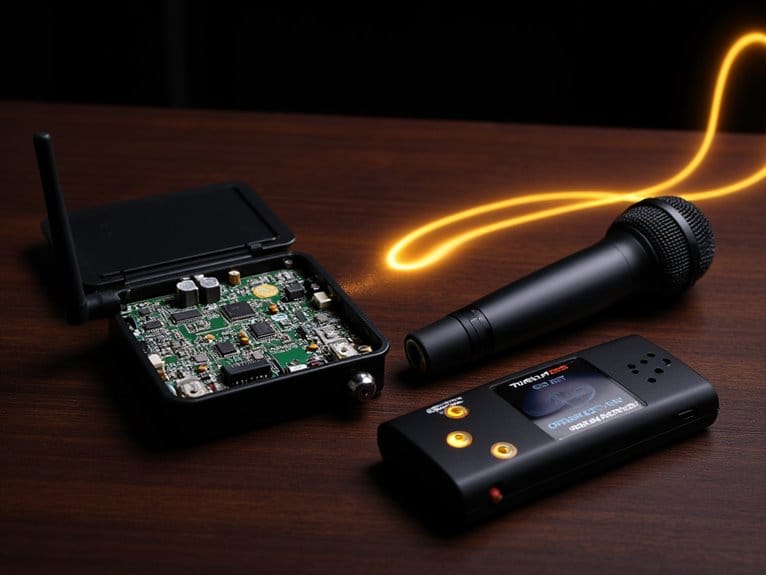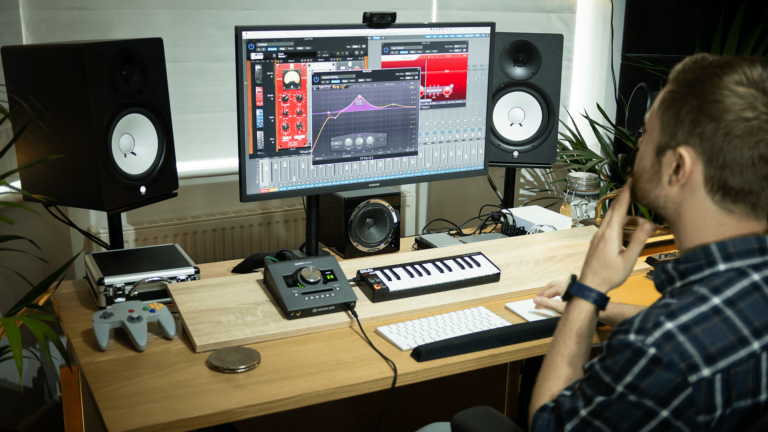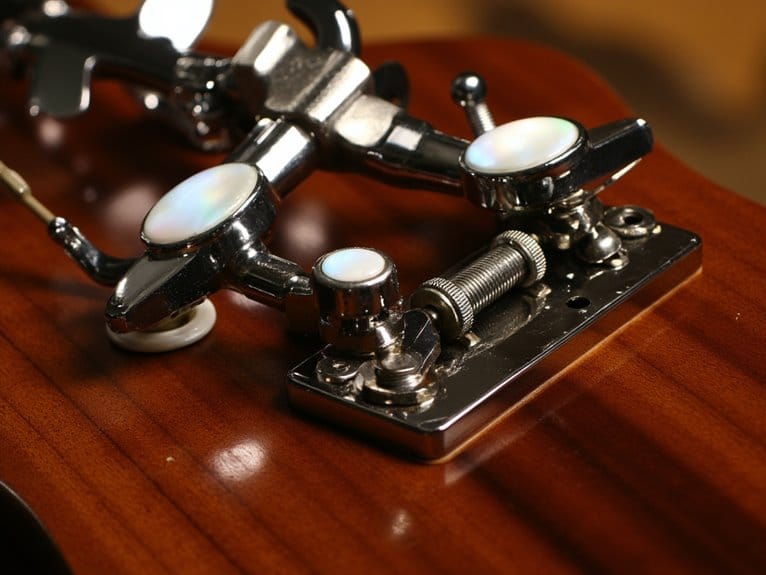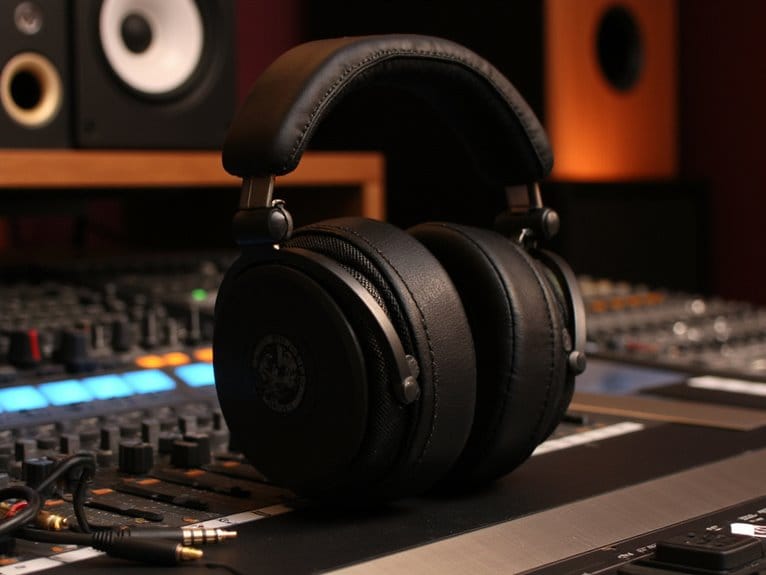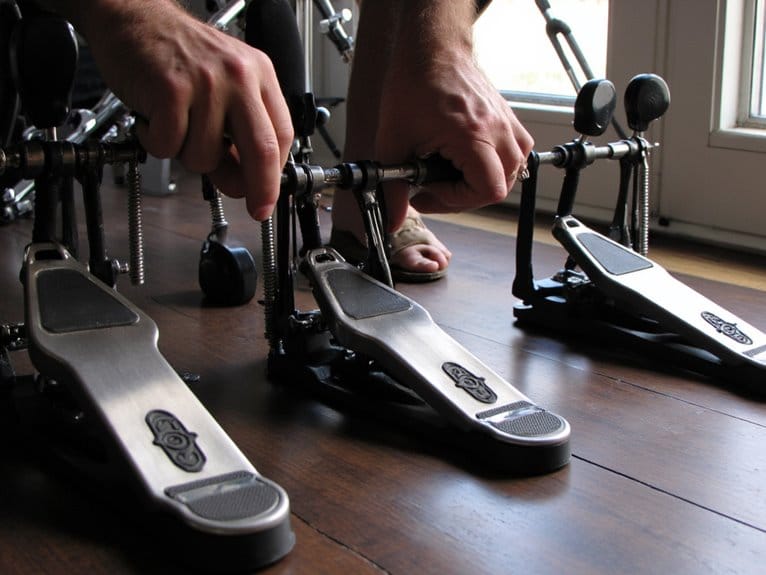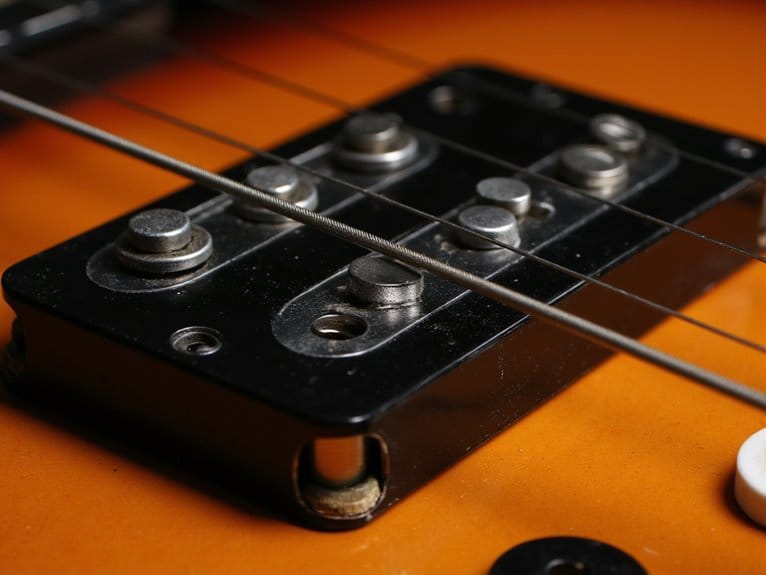Wireless Microphone Systems: How They Work
Wireless microphone systems convert your voice into electrical signals, then modulate them onto UHF radio frequency carrier waves that transmit through the air to diversity receivers equipped with dual antennas. Your microphone element captures acoustic energy while the transmitter unit—whether handheld, bodypack, or plug-on adapter—broadcasts at frequencies ranging from basic VHF to professional UHF bands, achieving 48kHz/24-bit recording quality with operational ranges extending up to 1,000 feet depending on line-of-sight conditions and environmental factors that affect signal clarity and performance optimization throughout your venue.
We are supported by our audience. When you purchase through links on our site, we may earn an affiliate commission, at no extra cost for you. Learn more.
Notable Insights
- Wireless microphones convert sound into electrical signals that are modulated onto radio frequency carrier waves for transmission.
- The system consists of a microphone element, transmitter unit, and receiver that demodulates signals back into audio.
- UHF frequencies are preferred over VHF due to superior range, reliability, and reduced interference from other devices.
- Diversity receivers use dual antennas and automatic frequency scanning to minimize signal dropouts and avoid RF interference.
- Audio signals are transmitted through electromagnetic waves in air, enabling mobility while maintaining professional recording quality.
The Fundamentals of Wireless Audio Transmission
Understanding wireless audio transmission might seem like rocket science at first glance, but I’ve found that breaking down the core principles makes it surprisingly straightforward for anyone to grasp.
When you speak into a wireless microphone, your voice gets converted into electrical signals that are then modulated onto radio frequency carrier waves, which travel through the air as electromagnetic waves to reach a receiver that demodulates and converts them back into audio signals.
This wireless technology operates in specific frequency bands, typically UHF or VHF ranges, depending on your region’s regulations and interference considerations. UHF frequencies deliver superior range and reliability compared to VHF systems. High-end systems offer advanced features like automatic frequency scanning to help minimize interference in crowded RF environments.
The entire audio transmission process happens in real-time with minimal latency, ensuring your voice reaches sound systems or recording devices with remarkable clarity and precision. Professional wireless systems typically maintain effective signal range within 160-200 feet, which is essential for performers who need freedom of movement during their performances. This radio wave technology offers exceptional flexibility in movement, making it perfect for performers who need to move around stages or venues without being tethered by cables.
Essential Components That Make Wireless Microphones Function
When you examine how wireless microphones actually work, you’ll discover that three core components handle the entire audio transmission process, from capturing your voice to delivering crystal-clear sound to the mixing board.
The microphone element converts acoustic energy into electrical signals, while sophisticated transmitter and receiver units manage the wireless radio frequency communication that eliminates those pesky cables we’ve all tripped over during performances. Different transmitter types include bodypack units for hands-free operation, handheld versions built directly into microphones, and plug-on adapters that convert wired microphones into wireless systems.
Behind the scenes, carefully engineered antenna systems and reliable power sources make certain your audio signal travels consistently across the venue, maintaining professional-grade quality that audiences expect from modern wireless technology. The receiver performs signal demodulation to extract the original audio from the radio waves and amplify it for your sound system or recording equipment. Professional systems achieve 48kHz/24-bit recording capability to ensure studio-grade sound quality throughout the wireless transmission process.
Microphone Element Technology
The heart of every wireless microphone system lies in its element technology, where acoustic energy transforms into electrical signals through precisely engineered transduction mechanisms that determine your audio quality from the very first moment sound waves reach the capsule.
Dynamic elements use moving coils and magnets to generate voltage without external power, while condenser designs rely on charged diaphragms requiring phantom power or batteries for operation.
Element efficiency directly impacts your signal-to-noise ratio, with higher-quality capsules delivering cleaner audio before wireless transmission begins.
Directional designs like cardioid and supercardioid patterns help you control pickup zones, reducing feedback and ambient noise in challenging environments. These microphone configurations work seamlessly with bodypack transmitters that attach discreetly to clothing for professional presentations.
Modern MEMS technology enables miniaturization without sacrificing performance, making lavalier and headset applications increasingly reliable for professional use. Digital transmission systems provide encrypted security that prevents unauthorized access to your audio signals during broadcast or recording sessions.
Transmitter and Receiver Units
Once you’ve selected the perfect microphone element for your application, that pristine audio signal needs to travel wirelessly from performer to sound system, and that’s where transmitter and receiver units become the backbone of your entire wireless setup.
Understanding transmitter functionality helps you appreciate how these devices convert your audio into stable RF signals using PLL controllers and internal antennas, while receiver design determines how effectively that signal gets captured and processed back into pristine audio.
Here’s what I’ve learned matters most in transmitter and receiver selection:
- Handheld vs. bodypack transmitters – choose based on your performance style and mic type requirements
- Diversity receiver systems – multiple antennas dramatically reduce dropouts compared to single-antenna designs
- Frequency scanning capabilities – essential for avoiding interference in crowded RF environments
The two main components work together as an integrated system, where transmitters handle the initial audio-to-radio conversion while receivers complete the process by converting those radio signals back into audio signals. Modern receivers can fit into standard IEA 19″ rack configurations, providing professional integration options for permanent installations.
Antenna and Power Systems
While transmitter and receiver units handle the signal conversion and processing, it’s the antenna and power systems that literally make your wireless microphone come alive, transforming electrical energy into radio waves that travel through space and back again.
Your system’s antenna types determine how effectively these signals transmit and receive—monopole antennas offer compact solutions for basic applications, while dipole antennas provide balanced reception for enhanced stability, and directional options like log periodic antennas extend range for demanding environments. Circularly polarized antennas eliminate up to 20dB of signal loss by maintaining equal electrical fields in both vertical and horizontal planes.
Meanwhile, power efficiency becomes essential since your transmitter relies on battery power, typically AA or lithium-ion cells, where optimized design directly impacts operation time and signal strength, ensuring your performance won’t fade when you need reliability most. Systems with diversity receivers utilize dual antennas to minimize signal dropouts and maintain consistent audio quality in challenging environments.
Radio Frequency Technology and Signal Transmission
When you press that wireless microphone‘s power button, you’re actually launching a sophisticated radio frequency transmission system that converts your voice into electromagnetic waves traveling through the air at the speed of light.
Here’s how your voice becomes a radio signal:
- Audio Conversion: Your microphone captures sound waves and converts them into electrical audio signals.
- Wireless modulation: The transmitter uses frequency modulation (FM) to embed your audio onto a carrier frequency, typically within UHF or VHF bands.
- Signal Reception: The receiver demodulates the RF signal, extracting your original audio for amplification.
The system operates within specific frequency bands, usually occupying about 200 kHz of spectrum around your chosen carrier frequency.
Advanced systems automatically scan channels to avoid RF interference from other devices, ensuring your voice reaches the sound system with remarkable clarity and minimal noise.
Key Differences From Traditional Wired Microphone Systems
When you’re choosing between wireless and wired microphone systems, you’ll encounter three fundamental differences that greatly impact your recording or performance experience.
The signal transmission methods vary dramatically, as wired systems send audio directly through physical cables while wireless models convert sound into radio frequency signals that travel through the air to receivers.
Your power requirements and mobility options also change completely, since wired mics draw electricity through their cables and keep you tethered to your equipment, whereas wireless systems rely on internal batteries but grant you complete freedom of movement. Most wireless systems provide 8-14 hours of operation depending on the battery type and model specifications.
Modern wireless systems offer impressive wireless ranges from 65 feet up to 1,000 feet depending on the model, though line-of-sight connectivity remains essential for maintaining optimal audio quality.
Signal Transmission Methods
Although wireless microphone systems accomplish the same fundamental goal as their wired counterparts—capturing and transmitting audio—the methods they use to move that sound from point A to point B couldn’t be more different.
While wired mics send electrical signals directly through cables, wireless systems convert your audio into radio frequency waves that travel invisibly through air. This transformation involves sophisticated modulation techniques, primarily frequency modulation (FM), which “hitchhikes” your voice onto carrier waves operating in UHF or VHF bands.
Here’s how wireless transmission differs from wired systems:
- Signal conversion – Audio becomes electromagnetic waves rather than electrical current.
- Transmission medium – Air replaces physical cables for signal transport.
- Processing complexity – Requires encoding, modulation, and interference management protocols.
This wireless approach grants you incredible mobility while maintaining audio quality through advanced digital processing.
Power and Mobility
While wireless microphones liberate you from cables, they introduce an entirely different set of power considerations that fundamentally change how you’ll approach audio setup and performance planning. Unlike wired mics that draw phantom power directly from your mixer, wireless transmitters demand dedicated battery management, with alkaline batteries providing 14-20 hours and rechargeable options lasting just 3 hours.
| Power Aspect | Wireless | Wired |
|---|---|---|
| Battery Life | 3-20 hours | N/A |
| Power Source | Internal batteries | Phantom power |
| Current Draw | 28 mA typical | Zero |
| Setup Complexity | Higher | Lower |
| Signal Stability | Battery-dependent | Consistent |
Your signal stability directly correlates with battery health, making power monitoring essential for maintaining audio quality throughout performances.
Popular Wireless Microphone Configurations and Types
The evolution of wireless microphone technology has produced several distinct configurations, each engineered to address specific performance requirements and user scenarios that I’ve encountered throughout years of audio production work.
You’ll find that choosing the right type depends heavily on your intended application, mobility needs, and budget constraints.
The best handheld systems feature built-in transmitters perfect for live performances, while lavalier options provide discreet broadcasting solutions.
Headworn advantages include hands-free operation during presentations, instrument mounted flexibility captures direct sound from musical sources, and clip on convenience offers easy clothing attachment.
- Frequency Range: Most systems operate on 2.4 GHz for stable transmission
- Distance Capability: Reliable transmission up to 50 meters
- Battery Performance: Several hours of continuous operation depending on usage patterns
VHF and UHF Frequency Bands Explained
Understanding frequency bands becomes essential when you’re selecting wireless microphone systems, and I’ve learned through countless productions that the choice between VHF and UHF can make or break your audio quality.
VHF advantages include strong penetration and compatibility with older equipment, making them suitable for basic conferences and educational settings. However, UHF disadvantages stem from the band’s congested nature, shared with digital TV and mobile services, creating potential conflicts during critical moments.
Interference issues plague both bands differently—VHF suffers from TV broadcast interference, while UHF contends with digital television and cellular signals.
Despite these challenges, UHF’s superior anti-interference capabilities and signal stability make it the professional standard.
Transmitter and Receiver Operations
When you’re dealing with wireless microphone systems, the transmitter’s job becomes crystal clear—it’s the workhorse that converts your voice into radio waves, whether it’s built into a handheld unit or packed into that small body-pack transmitter clipped to your belt.
The transmitter modulation process involves complex circuitry, including programmable frequency dividers and phase-locked loop controllers that guarantee your audio signal gets accurately converted into RF signals for wireless transmission.
On the receiving end, your receiver performs the opposite function through receiver demodulation, converting those radio waves back into clean audio signals identical to what you’d expect from a wired microphone.
Here’s what makes this system tick:
- Power Management – Your 9-volt alkaline battery keeps everything running smoothly.
- Signal Processing – Advanced filters guarantee audio quality while reducing interference.
- Integration Capability – Direct connection to PA systems through standard microphone inputs.
Common Challenges and Technical Considerations
Despite wireless microphone systems offering remarkable flexibility and convenience, I’ve learned through years of field experience that they introduce a complex web of technical challenges that can quickly turn your polished presentation into a frustrating ordeal if you’re not prepared.
Wireless microphones provide incredible flexibility, but years of experience have taught me they can transform seamless presentations into technical nightmares without proper preparation.
The primary hurdles you’ll face include:
- Interference sources from Wi-Fi networks, Bluetooth devices, and competing wireless systems that create signal dropouts and static during critical moments
- Battery management protocols requiring constant monitoring, strategic replacement timing, and backup power solutions to prevent mid-presentation failures
- Range limitations imposed by physical barriers, environmental factors, and the fundamental need for optimized antenna placement
Professional-grade frequency analyzers help identify problematic interference sources, while establishing systematic battery swap protocols guarantees reliable operation throughout extended sessions.
Frequently Asked Questions
How Much Do Professional Wireless Microphone Systems Typically Cost?
You’ll find professional wireless microphone systems range from $30-65 for budget options with basic UHF frequency and 160-foot range.
Mid-range models cost $115-200 offering multiple channels and improved stability.
High end models typically run $300-350 or more for 8-channel systems with advanced frequency management and broadcast-quality features, though I’ve noticed pricing varies considerably based on antenna quality, battery systems, and brand reputation.
How Long Do Batteries Last in Wireless Microphone Transmitters?
Your wireless mic transmitter‘s battery will typically last 6-8 hours, though I’ve seen this drop to around 6 hours with onboard recording enabled, while some models stretch to 10 hours without extra features.
Battery types matter considerably—lithium-ion rechargeable units offer better longevity than replaceable AAs.
For usage tips, disable power-hungry features when possible, use low-power transmission modes, and always charge fully before events.
On a final note
You’ve now got the foundation to understand how wireless microphone systems operate, from radio frequency transmission to the intricate dance between transmitters and receivers. While you’ll encounter challenges like interference and battery management, the freedom and flexibility these systems provide often outweigh the complexities. Whether you’re choosing VHF or UHF frequencies, remember that proper setup and frequency coordination will determine your success in achieving reliable, professional-quality wireless audio transmission.

